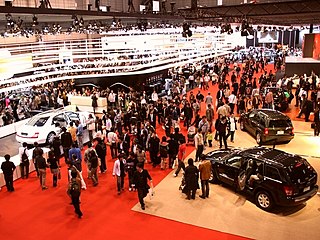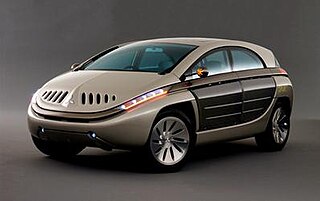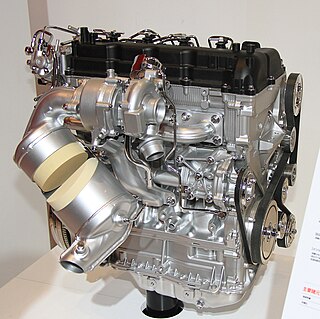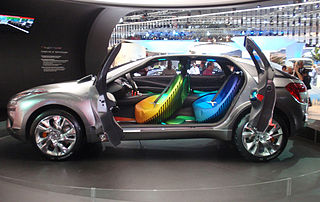| Mitsubishi Concept-ZT | |
|---|---|
 | |
| Overview | |
| Manufacturer | Mitsubishi Motors |
| Production | 2007 |
| Body and chassis | |
| Class | Compact car Concept car |
| Layout | Front engine, four-wheel drive |
| Powertrain | |
| Engine | 4N14 2.2 L I4 turbodiesel |
| Transmission | SST twin-clutch transmission |
| Dimensions | |
| Wheelbase | 2,815 mm (110.8 in) |
| Length | 4,950 mm (194.9 in) |
| Width | 1,820 mm (71.7 in) |
| Height | 1,440 mm (56.7 in) |
The Mitsubishi Concept-ZT is a concept car developed by Japanese automaker Mitsubishi Motors, and first exhibited at the 40th Tokyo Motor Show in September 2007. [1]

A concept car is a car made to showcase new styling and/or new technology. They are often shown at motor shows to gauge customer reaction to new and radical designs which may or may not be mass-produced. General Motors designer Harley Earl is generally credited with inventing the concept car, and did much to popularize it through its traveling Motorama shows of the 1950s.

Japan is an island country in East Asia. Located in the Pacific Ocean, it lies off the eastern coast of the Asian continent and stretches from the Sea of Okhotsk in the north to the East China Sea and the Philippine Sea in the south.
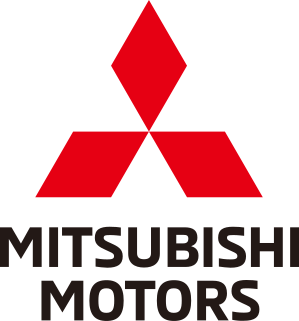
Mitsubishi Motors Corporation is a Japanese multinational automotive manufacturer headquartered in Minato, Tokyo, Japan. In 2011, Mitsubishi Motors was the sixth-biggest Japanese automaker and the nineteenth-biggest worldwide by production. From October 2016 onwards, Mitsubishi has been one-third (34%) owned by Nissan, and thus a part of the Renault–Nissan–Mitsubishi Alliance.
The car has an aluminium space frame chassis, and features a 4N14 2.2-litre clean diesel producing 140 kW (190 PS ) and 400 N⋅m (300 lb⋅ft ), powering all four wheels through the company's S-AWC drivetrain and SST twin-clutch transmission. Following the lead of other recent Mitsubishi prototypes, "green plastic" recyclable resin is used extensively in the body panels and interior for environmental reasons. [2]

Aluminium or aluminum is a chemical element with symbol Al and atomic number 13. It is a silvery-white, soft, nonmagnetic and ductile metal in the boron group. By mass, aluminium makes up about 8% of the Earth's crust; it is the third most abundant element after oxygen and silicon and the most abundant metal in the crust, though it is less common in the mantle below. The chief ore of aluminium is bauxite. Aluminium metal is so chemically reactive that native specimens are rare and limited to extreme reducing environments. Instead, it is found combined in over 270 different minerals.

In architecture and structural engineering, a space frame or space structure is a rigid, lightweight, truss-like structure constructed from interlocking struts in a geometric pattern. Space frames can be used to span large areas with few interior supports. Like the truss, a space frame is strong because of the inherent rigidity of the triangle; flexing loads are transmitted as tension and compression loads along the length of each strut. Steel space frames provide great freedom of expression and composition as well as the possibility to evenly distribute loads along each rod and external constraints. With these features, steel space frames can be used to achieve also complex geometries with a structural weight lower than any other solution. The inner highly hyper-static system provides an increased resistance to damages caused by fire, explosions, shocks and earthquakes. Space frames are modular and made of highly industrialized elements designed with a remarkable dimensional accuracy and precise surface finish.

A chassis is the framework of an artificial object, which supports the object in its construction and use. An example of a chassis is a vehicle frame, the underpart of a motor vehicle, on which the body is mounted; if the running gear such as wheels and transmission, and sometimes even the driver's seat, are included, then the assembly is described as a rolling chassis.
Although there was initially no official confirmation, the automotive press was confident that this prototype presaged the next generation of the Mitsubishi Galant, [3] [4] [5] and the Galant-based Mitsubishi 380 in Australia. [6] However, in August 2008 the company announced that it had abandoned production plans using the same drivetrain and a steel body, claiming they could no longer make a business case for the car. [7]

The Mitsubishi Galant is an automobile which was produced by Japanese manufacturer Mitsubishi from 1969 to 2012. The model name was derived from the French word galant, meaning "chivalrous". There have been nine distinct generations with total cumulative sales exceeding five million units. It began as a compact sedan, but over the course of its life evolved into a mid-size car. Initial production was based in Japan, but from 1994 the American market was served by vehicles assembled at the former Diamond-Star Motors (DSM) facility in Normal, Illinois.

The Mitsubishi 380 is a mid-size car that was produced between 2005 to 2008 by Mitsubishi Motors Australia. Available only as a sedan, it marked the end of Australian production by the Japanese manufacturer.

Steel is an alloy of iron and carbon, and sometimes other elements. Because of its high tensile strength and low cost, it is a major component used in buildings, infrastructure, tools, ships, automobiles, machines, appliances, and weapons.





